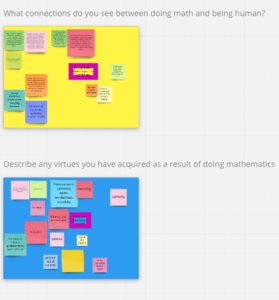Pandemic Teaching Fragment #2
Over the summer I read a lot about teaching online, and one consistent theme was that it’s a different medium than teaching in person — some things we do in person don’t work online, but there are alternatives more suited to the medium. Last week my students and I stumbled into an a way to have a full class discussion when we were all remote that left me actually excited and thinking that the online discussion was better than what we would have done in-person.
In my Math Explorations class, students are all reading Mathematics for Human Flourishing by Francis Su. I wanted to make sure we discussed some of the text in the first chapter before I assigned the next one, and I also thought it would be good to spend some time all together, as we’d mostly been in breakout rooms earlier in the week. As I was rereading Chapter 2 before class, I went to the back of the book to look at a footnote and saw the discussion questions at the back, which I’d forgotten about. I decided to set up an online whiteboard with four color-coded frames for four different questions. The first question was, “What is mathematics? How would you describe it to a friend in a sentence or two?”

Over the summer, I was part of a group of faculty from the New England Inquiry Based Learning in Mathematics (NE-IBLM) community, who worked together to study some math, which ended up being a great model for improving our skills at remote teaching. We tried out several online whiteboards over the summer, all of which proved disappointing. By the time I tried the Miro Whiteboard and thought it was potentially better than the ones we’d tried, no one else wanted to try another whiteboard: the others had decided to stick with the Zoom whiteboard or to use Google Docs or Slides as a whiteboard. Since Google is blocked in China and about one-third of my students this semester are in China, that option was out for me. I thought I might use Word or PowerPoint instead, but there was too much lag time to use them for drawing, even with just two devices of mine.
I started the semester intending a minimalist approach, thinking I’d just try to make the Zoom whiteboard work. However, not being able to copy/paste pictures or to erase other people’s work made that whiteboard sub-optimal for the game we played in my other classes, which led me to try the Miro board in all my classes. I was still figuring out how to organize my boards so that student “team members” couldn’t see the boards from classes they aren’t in, and so I hadn’t had my Math Explorations students sign up officially yet. They were using the boards anonymously, which ended up being a key feature of our successful discussion.
We went through the discussion questions one at a time; the students started by going to the correct board and writing their own, anonymous answer on a sticky note (for the first few some typed anywhere, but the stickies worked better). After everyone had typed an answer, I invited students to move the stickies around to group similar answers. Then I looked at the answers and called on people to share, e.g. in answer to, “Describe any virtues you have acquired as a result of doing mathematics,” two students wrote, “Curiosity.” So I asked who gave that answer, and if they could say more, and after one student shared, I asked the other one who they were and what they were thinking when they wrote that.
With each, “Who said this?” question there was a pause, and I wasn’t sure whether a student would claim the answer, but all of them did. There were twenty students in the class, and I called on over half of them; there was only one student who I called on twice. Toward the end I invited students who hadn’t spoken yet to add to the discussion, and a few did. The discussion didn’t have much cross-talk between students, but I think we could work on that in the future.
During the discussion, I was acutely aware that this process was overriding some of my biases: had I been calling on students “randomly” I would have favored students who had their cameras on and probably I would have also favored students whose names I had learned to pronounce. Afterward, many of the students said specifically that starting anonymously and then being called on worked well for them. I don’t know how I could have replicated this switch between being anonymous and public in the classroom (other than by using online tools). If students had posted stickies on a physical whiteboard, we’d have had to write very big and would have seen who posted where. I could have used index cards or popsicle sticks to call on students randomly, but then I would have lost calling on them because of specific interest in their thoughts.
After the discussion I was excited to have found some harmony with the medium of a Zoom discussion, and I was aware of how much calmer I am now than I was in the spring, where I was just trying to salvage something.
Leave a Reply